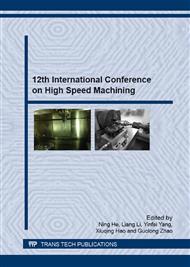p.126
p.132
p.139
p.147
p.155
p.161
p.168
p.177
p.185
Study on the Cutting Force and Machined Surface Quality of Milling AFRP
Abstract:
AFRP(Aramid Fiber Reinforced Plastics) is widely used in the aerospace and automotive while there are many problems in machining AFRP such as furry, delamination, burns and so on. Milling experiments of AFRP have been conducted to study the influence of different helix angle (0°, 30°, 60°) and cutting tools (traditional end mill, multiple flute end mill and compression end mill) on cutting force and machined surface quality. The results indicated that the cutting force has been reduced and the surface quality has been improved with the increase of helix angle. The cutting tool structure can make greater influence on machined surface quality than the cutting parameters. A cutting tool with the structure of multiple flute or herringbone cutting edge could reduce the axial cutting force. However the cutting force is too small to cut off fibers when using a multiple flute end mill. A good processing surface can be achieved while cutting with a compression end mill or a tool with big helix angle.
Info:
Periodical:
Pages:
155-160
Citation:
Online since:
January 2016
Authors:
Keywords:
Price:
Сopyright:
© 2016 Trans Tech Publications Ltd. All Rights Reserved
Share:
Citation:


